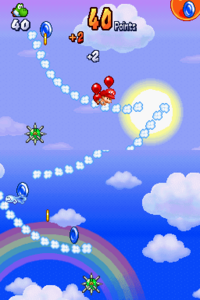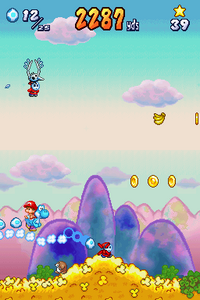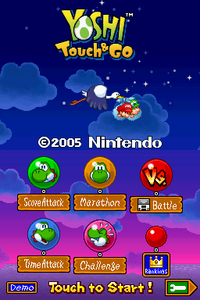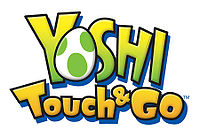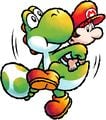Yoshi Touch & Go: Difference between revisions
No edit summary |
No edit summary |
||
| Line 5: | Line 5: | ||
|developer=[[Nintendo Entertainment Analysis and Development|Nintendo EAD]] | |developer=[[Nintendo Entertainment Analysis and Development|Nintendo EAD]] | ||
|publisher=[[Nintendo]] | |publisher=[[Nintendo]] | ||
|released='''Nintendo DS'''<br>{{released|Japan|January 27, 2005|ROC|January 27, 2005|USA|March 14, 2005|Europe|May 6, 2005|Australia|May 19, 2005|China|February 14, 2006}} '''Virtual Console (Wii U) (Full Release)'''<br>{{released|USA|April 9, 2015|Europe|July 23, 2015|Australia|July 24, 2015|Japan|May 18, 2016}} '''Virtual Console (Wii U) (Promotional Release)'''<br>{{released|Australia|June 25, 2015|Europe|June 26, 2015}}'''Nintendo Switch'''<br>{{released|Japan|April 10, 2020|USA|May 30, 2020|Europe|June 4, 2020|China|July 7, 2020}}'''Nintendo 3DS'''<br>{{release|China|March 19, 2020|USA|May 30, 2020|Australia|August 29, 2020|Japan|December 1, 2020}} | |released='''Nintendo DS'''<br>{{released|Japan|January 27, 2005|ROC|January 27, 2005|USA|March 14, 2005|Europe|May 6, 2005|Australia|May 19, 2005|China|February 14, 2006}} '''Virtual Console (Wii U) (Full Release)'''<br>{{released|USA|April 9, 2015|Europe|July 23, 2015|Australia|July 24, 2015|Japan|May 18, 2016}} '''Virtual Console (Wii U) (Promotional Release)'''<br>{{released|Australia|June 25, 2015|Europe|June 26, 2015}} | ||
'''Nintendo Switch'''<br>{{released|Japan|April 10, 2020|USA|May 30, 2020|Europe|June 4, 2020|China|July 7, 2020}} | |||
'''Nintendo 3DS'''<br>{{release|China|March 19, 2020|USA|May 30, 2020|Australia|August 29, 2020|Japan|December 1, 2020}} | |||
|genre=Platformer/Puzzle | |genre=Platformer/Puzzle | ||
|modes=Single player, Multiplayer | |modes=Single player, Multiplayer | ||
Revision as of 04:21, October 9, 2019
It has been requested that this article be rewritten and expanded to include more information. Reason: include worlds and levels
Template:Infobox Yoshi Touch & Go is a Nintendo DS game developed by Nintendo EAD and first released in Japan and the ROC on January 27, 2005. It is the only spin-off game in the Yoshi's Island series. Here, the player guides Yoshi and Baby Mario through an array of side-scrolling courses. The game is almost entirely touch driven, using the DS's stylus to fire eggs at enemies, trap them in bubbles, and build bridges or ramps for Yoshi to walk on. The game was later rereleased for the Virtual Console for the Wii U, and Nintendo Switch is scheduled to be release on May 30, 2020.
Gameplay
Main controls
This game, for the most part, has the player shuttling Yoshi and Baby Mario over the ground to safety at the stork. Yoshi cannot be controlled directly; he must be guided on his way with the clouds made from the stylus touching the screen. Whenever the player sweeps the stylus over the screen, a cloud bridge appears, making for a game experience much like Mario & Wario. A blow into the microphone will sweep all clouds onscreen away, in case the screen has become clogged. These clouds must be utilized to keep Yoshi and Baby Mario from danger; a single hit from an enemy will do them in. Enemies cannot go through a cloud from under, but they can use the surface to walk on.
Fortunately, the player can use a special power to Yoshi’s advantage. When a semi-perfect cloud circle is drawn, it will morph into a circular bubble. This bubble can be thrown with the stylus by swishing the pen, then removing it from the screen. Bubbles can be used to push enemies away or, better yet, if a bubble is drawn over an enemy, the bubble will trap the enemy inside, turning it into a coin. Different enemies have different values; for example, Shy Guys are only worth one Yellow Coin while a Fly Guy is worth a Blue Coin. Multiple enemies can be trapped in bubbles; the more that are trapped, the more bonus points will be earned. But beware: some enemies, like Briers, cannot be trapped, as they have spikes protecting them that will pop any bubbles drawn around. If a bubble is thrown to Yoshi, it will pop and the coins inside will be immediately obtained.
Another way to destroy enemies and to collect coins is to shoot eggs. Eggs are obtained and act in a way quite differently than in other Yoshi titles: Eggs are collected by eating fruit. Different fruits have different values; the smallest one being apple, the largest being the delicious melon. Fruits are eaten when Yoshi gets near them; he will automatically swallow them and lay the eggs obtained. Fruit can be grabbed in a bubble and thrown to Yoshi for more ammo as well. The number of eggs Yoshi can carry depends on color. The green Yoshi can carry the lowest amount, the black Yoshi the most. An egg is thrown by lightly touching the touch screen with the stylus. An egg will be thrown in the direction where the screen was touched. If an enemy is hit with an egg, the points given will be the same as if the enemy was a coin. For instance, a Shy Guy is worth one Yellow Coin, or one point. It can be grabbed in a bubble to make it become a Coin, or be shot with an egg to quickly obtain its point worth. In this game, eggs, instead of bursting once having hit too many walls, will bounce about until flying off the screen, making item collection in enclosed caves a snap.
Even Yoshi himself acts different. Besides egg-throwing, he can only jump and flutter. Tapping his hindquarters causes him to jump; tapping again while he is in the air will make him flutter, which can be repeated infinitely while he is floating in midair.
Story
Unlike all other Yoshi games, this game has no story. Every game mode begins with Kamek smashing into the Stork and making off with Baby Luigi, while Baby Mario falls toward the land below, beginning the game. Every mode begins with Baby Mario falling toward the ground, while the player must use clouds to guide him to the ground and bubbles to destroy enemies. The sky level differs depending on the mode selected; for instance, the Time Attack mode has Super Stars hovering in the air for Baby Mario to reach the air faster, there is also a timer and bumpers to obstruct the baby's fall. Each level has the following in common:
- Baby Mario has three balloons, which act as his HP. When he hits an enemy, one of them pops. If all three pop, he falls to the ground and is captured by Kamek.
- Baby Mario can be guided by clouds drawn with the stylus. If an enemy is captured in a bubble, the bubble can be thrown to Baby Mario to pop it.
- The color of the Yoshi below (more on this below) depends on how many points Yoshi earns. (In Time Attack mode, the color depends on how fast Baby Mario descends).
- Finally, when Baby Mario nears the ground, there are small formations of tree leaves. Touching them with the stylus may reveal a treat!
When Baby Mario reaches the ground, a Yoshi is awaiting him. The color of the Yoshi depends on how many points Yoshi has collected, or how fast he came down. Coloring of the Yoshi influences how fast it runs, plus how many eggs it can carry. The lowest Yoshi color is green, the highest is black. The color changes from green to light blue at 60, level-ups are given every 20 points up.
Modes
The game has four modes; the first two are unlocked from the start, the others must be unlocked by beating the top score for the first two.
- In the first mode, "Score Attack", Yoshi and Baby Mario must trek 1000 yards to where the Stork awaits. The more points collected, the better.
- The second mode, "Marathon", involves Yoshi and Mario racing nonstop across an unlimited expanse of terrain. Every 1000 yards, Mario is handed over to the next color rank of Yoshi, and every 100 points that are collected earns Mario a Super Star.
- The third mode, "Time Attack", differs heavily from the other modes. In this mode, the sky level has more enemies, bumpers that bounce Baby Mario about, and Super Stars Baby Mario can grab. On the ground, Baby Mario and Yoshi must catch up to Toadies carrying Baby Luigi away. The clouds are yellow now, allowing Yoshi to run faster on them. To save Baby Luigi, Yoshi must barrage the Toadies until they drop the baby. The faster Yoshi saves him, the more points earned.
- "Challenge" mode is the hardest, a cross between Time Attack and Marathon. Yoshi and Baby Mario walk across an unlimited amount of terrain, like Marathon, but if the timer on the screen runs out, Kamek swoops in, stealing the baby and ending the game.
For Battle/Versus mode, the rules are very simple. The clouds are also yellow here. If one Yoshi manages to go far enough, a ending goal with Yoshi's face on it appears. Whichever Yoshi goes through it first makes the other Yoshi knocked out and lose. The only enemies are Marucchi, but if the player defeats lots of enemies in a row with an egg, a few red spiked Briers appears on the opponent's screen. The first Yoshi to be knocked out loses. There is no end, so it is no competition.
Yoshis
The following table displays information pertaining which color of Yoshi the player controls during the Marathon Mode. During this mode, White Yoshi may randomly be played during one 1,000 yard run, after having finished one 1,000 yard run as a Black Yoshi.
| Color of Yoshi | Distance | Number of eggs |
|---|---|---|
Green Yoshi |
1,000-2,000 yards | 20 eggs |
Light Blue Yoshi |
2,000-3,000 yards | 25 eggs |
Pink Yoshi |
3,000-4,000 yards | 30 eggs |
Blue Yoshi |
4,000-5,000 yards | 35 eggs |
Yellow Yoshi |
5,000-6,000 yards | 40 eggs |
Red Yoshi |
6,000-7,000 yards | 45 eggs |
Black Yoshi |
7,000-10,000 yards | 50 eggs |
Orange Yoshi |
10,000-20,000 yards | 50 eggs |
Purple Yoshi |
20,000+ yards | 50 eggs |
White Yoshi |
Performance Related | Unlimited |
Enemies
Every enemy, how to defeat them, and how much each one is worth.
- Brier: A spiny plant that can only be defeated using an egg. A non-spiky version, known as Marucchi, also appears that can be encircled. Worth two points.
- Cheep Cheep: Leaps out of watery ponds. Worth a two points.
- Cloud Drop: Capers about in a set course. Worth a Blue Coin.
- Fly Guy: Same as Shy Guy, but harder to stomp and flies about. Worth a Blue Coin.
- Goonie: Can only be shot with egg, as it flies in the top screen. If shot, it will drop down as a Flightless Goonie. Also appears in skeletal form. Worth a Blue Coin.
- Gusty: Races past at various speeds. Worth two points.
- Lakitu: The original Lakitu appears occasionally, flying by in the top screen. Wall Lakitus also appear, and they can only be hit with eggs. Flying Lakitu worth five points, while Wall Lakitu are worth two.
- Monty Mole: Pops out from ground and races for Yoshi. Worth a Blue Coin.
- Piranha Plant: Lies in wait for Yoshi. Wild Ptooie Piranhas also appear, which spit Spiny Eggs rather than Needlenoses. Worth two points.
- Propeller Mūcho: Shoots flying balls that can only be destroyed by eggs. Worth a Blue Coin.
- Shy Guy: Kamek's main grunts, vulnerable to all attacks. Worth a Yellow Coin.
- Spiny Cheep-Cheep: A blue Cheep Cheep with spikes somewhat more aggressive that its red counterpart. It can only be destroyed with an egg. Worth four points.
- Tap-Tap: Invincible; can only be destroyed by bonking into another Tap-Tap. If shot with an egg, it will roll, destroying all enemies in its way. Worth two points.
- Toady: Homes in on Yoshi. Worth a Blue Coin.
- Ukiki: Hops about, oblivious to Yoshi. Also hides in trees and drops bombs (Short Fuse) and Needlenoses (Seedy Sally), but also drops bananas. Worth a Blue Coin.
Development
Yoshi Touch & Go was initially planned to be a Nintendo GameCube game; specifically, it would be a puzzle-oriented, horizontal platformer centering on the basic concept of Yoshi protecting Baby Mario. It would also use the GameCube controller and was said to have apparently always focused on drawing as a major gameplay element, although such a statement may have been referring to the game's later Nintendo DS version when spoken by the developers [1]. Sometime during the game's development, it would appear to have split into both a Nintendo DS and GameCube version (the latter of which was favored by Shigeru Miyamoto), the developers undecided as to which one would be released.
A work-in-progress Yoshi Touch & Go was first revealed to the public in the form of an E3 2004 Tech Demo known as Balloon Trip. Though Balloon Trip featured only the sky segments that would later be used in the final version of Yoshi Touch & Go, it did so in a manner almost identical to that of Yoshi Touch & Go's final version. Balloon Trip proved itself successful enough for Nintendo to permit its developers to release it as a full game, and the team working on it soon grew. Balloon Trip's success also helped the developers in deciding to cancel the GameCube version of Yoshi Touch & Go and completely move their project to the Nintendo DS. On October 7th, 2004, Yoshi Touch & Go was announced as a full game, and it was released on January 27th, 2005 in Japan, featuring several differences from Balloon Trip, one of the most noticeable of which being its ground stages (which may have been inspired by the puzzle-platformer elements of the canceled GameCube version), It is scheduled to be release at Nintendo Switch on May 30, 2020.
Reception
| Reviews | |||
|---|---|---|---|
| Release | Reviewer, Publication | Score | Verdict |
| Nintendo DS | Carig Harris, IGN | 8.8/10 | "Really, the only harsh criticism that can be attached to Yoshi Touch & Go is that it breaks from the expected "beginning, middle, and end" platform presentation, instead going back to the old-school arcade days of trying to see how far you can get on a single try. And I'll admit that, initially, it was someone concerning to discover the lack of an extensive level progression in the latest Yoshi game. But the game modes offer an enormous amount of replay in their simplistic design; the main game mode has a ton of "combo" strings to discover and pull off. Marathon Mode constantly offers a fresh take on the same Yoshi rounds by randomizing challenges throughout the run-through. And the intense multiplayer mode is incredibly hard to turn off once it gets started. It was difficult to see the direction Nintendo was heading with the concept of Yoshi Touch & Go back at E3, or at the very least, how it was all going to come together as a full-fledged gaming package. But in its final form, Nintendo succeeded admirably, both in game concept and in an experience that can't be obtained anywhere else but on the Nintendo DS platform. Don't expect and extension of the Yoshi's Island series on the DS, as this game doesn't come anywhere close to attempting the next generation of platform design. Rather, what you're getting is a wonderful throwback to the days of self-competition: Nintendo's "Donkey Kong" arcade game of the 21st century." |
| Nintendo DS | Phil Theobald, Gamespy | 3.5/5 | "Like the recently released DS game, Pokemon Dash, this game feels like a mini-game that was hastily turned into a full product. The main difference here, however, is that Touch & Go is actually fun to play. Hopefully though, Nintendo is working on something a little more substantial for its dual screened system. These gimmicky titles, regardless of how much fun they are, can't carry the hardware for long." |
| Nintendo DS | Tom Bramwell, Eurogamer | 6/10 | "Ultimately, Yoshi's Touch & Go looks like it's asking a difficult question, but it never really does because the core concept - whilst interesting, different and certainly as well executed as it can be - never quite hits the level of compulsiveness and excitement that other high-score games like Meteos and Zoo Keeper and, to a certain extent, the Mario 64 DS mini-games have already hit. It'll be well worth checking out when it hits £15, but until then it's Yoshi's Touch & Go." |
| Aggregators | |||
| Compiler | Template:Nowrap | ||
| Metacritic | 73 | ||
| GameRankings | 75.01% | ||
References to other games
- Super Mario Bros. - There are three sets of high-score icons to use on the high-score table: One based on the Yoshi franchise, one based the Mario franchise, and one that uses the same characters of the previous set, but uses original sprites from this game instead. Also, the stomping and shell-hitting sound effects from this game are re-used in Yoshi Touch & Go.
- Super Mario World 2: Yoshi's Island - This game's story is basically retold in Yoshi Touch & Go. The enemies from this game also return, as well as music which is covered and heard in some levels.
- Mario Kart: Double Dash!! - The Mario series high-score icons previously mentioned uses the same design as the ones from this game. Various voice clips are reused from this game.
References in later games
- Super Smash Bros. Brawl - The "Flower Field" music returns as a cover for the Yoshi's Island stage.
Staff
- Main article: List of Yoshi Touch & Go staff
Gallery
- For this subject's image gallery, see Gallery:Yoshi Touch & Go.
Yoshi and Baby Mario
Stork holding Baby Mario and Baby Luigi
Media
Names in other languages
| Language | Name | Meaning | Notes |
|---|---|---|---|
| Japanese | キャッチ!タッチ!ヨッシー![?] Kyacchi! Tacchi! Yosshī! |
Catch! Touch! Yoshi! | |
| Chinese | 摸摸耀西-云中漫步 (iQue, Simplified Chinese)[2] Mōmō Yàoxī: Yúnzhōng Mànbù |
Touch Yoshi: Strolling in Clouds |
Trivia
- The "Touch & Go" in this game's title is a phrase more or less synonymous with "risky".
- This game contains the famous "Totaka's Song", a little tune included in almost every game where Kazumi Totaka is a member of the music staff in addition to voicing Yoshi. Here, pausing in the windy area explored in Marathon Mode to allow the background music to loop long enough will yield a short section with the Totaka song's notes.
- When Baby Mario lands on Yoshi's saddle, during the cutscene, the player can touch Baby Mario with the stylus to tickle him and make him laugh.
References
- ^ The Making of the Game: Yoshi's Touch & Go from N-sider.com
- ^ iQue. 摸摸耀西-云中漫步. Retrieved December 3, 2016.
| Yoshi Touch & Go | ||
|---|---|---|
| Characters | Baby Luigi • Baby Mario • Kamek • Stork • Yoshis | |
| Items | Blue Coin • Bubble • Fruit (Apple · Banana · Grape · Melon · Watermelon) • Red Coin • Yellow Coin • Yoshi's Egg | |
| Enemies | Brier • Cheep Cheep • Cloud Drop • Fang • Fly Guy • Goonie • Gusty • Kamek's Toadies • Lakitu • Marutchi • Monty Mole • Needle • Piranha Plant • Propeller Mūcho • Shy Guy • Spiny Cheep-Cheep • Tap-Tap • Toady • Ukiki • Whirly Fly Guy • Wild Ptooie Piranha | |
| Other | Gallery • Media • Staff | |
